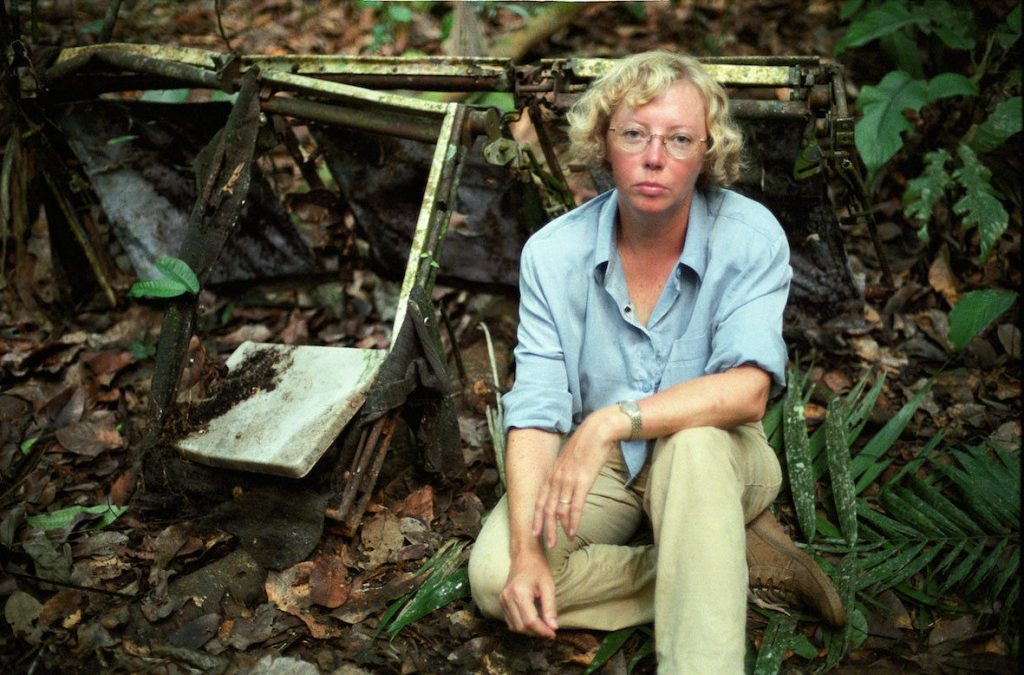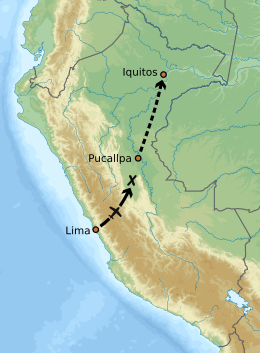Aerospace
She fell 10,000 ft to earth strapped to a seat and lived..!!

Juliane Diller (born 10 October 1954 in Lima as Juliane Margaret Koepcke) is a German biologist, born in Peru to German emigrants who is best known for being the sole survivor of 92 passengers and crew in the 24 December 1971, crash of LANSA Flight 508 (a LANSA Lockheed Electra OB-R-941 commercial airliner) in the Peruvian rain forest. After her airliner broke up in midair, she survived after falling about 3 km (10,000 feet) still strapped to her airliner seat, before the seat crashed through the rain forest canopy and came to rest on the forest floor.
Pakistan: Plane crashes with 40 passengers on board(Opens in a new browser tab)
Airplane crash: Juliane Koepcke was a German Peruvian high school senior student studying in Lima, intending to become a zoologist, like her parents. She and her mother, ornithologist Maria Koepcke, were traveling to meet with her father, biologist Hans-Wilhelm Koepcke, who was working in the city of Pucallpa.
Image: Juliane Koepcke revisited the crash site in 1998 for Werner Herzog’s documentary Wings of Hope

Image: Juliane Koepcke revisited the crash site in 1998 for Werner Herzog’s documentary Wings of Hope
The airplane was struck by lightning during a severe thunderstorm and broke up in mid-air, disintegrating at 3.2 km (10,000 ft). Koepcke, who was seventeen years old at the time, fell to earth still strapped into her seat. She survived the fall with only a broken collarbone, a gash to her right arm, and her right eye swollen shut. “I was definitely strapped in [the airplane seat] when I fell,” she remembered. “It must have turned and buffered the crash, otherwise I wouldn’t have survived.”
Her first priority was to find her mother, who had been seated next to her on the plane but her search was unsuccessful. With her eyeglasses lost and one eye swollen shut, she struggled to no avail. She later found out her mother had initially survived the crash as well, but died several days later due to her injuries.
Koepcke found some sweets which were to become her only food on her trip. After looking for her mother and other passengers, she was soon able to locate a small stream. She then waded through knee-high water downstream from her landing site, relying on the survival principle her father had taught her, that tracking downstream should eventually lead to civilization. The stream also provided clean water and a natural path through the dense rainforest vegetation.
During the trip, Koepcke couldn’t sleep at night due to numerous insect bites, which became infected. After nine days, several spent floating downstream, she found a boat moored near a shelter, where she found the boat’s motor and fuel tank. Relying again on her father’s advice, Koepcke poured gasoline on her wounds, which managed to extract thirty five maggots from one arm, then waited until rescuers arrived. She later recounted her necessary efforts that day: “I remember having seen my father when he cured a dog of worms in the jungle with gasoline. I got some gasoline and poured it on myself. I counted the worms when they started to slip out. There were 40 on my arm. I remained there but I wanted to leave. I didn’t want to take the boat because I didn’t want to steal it.”
Juliane Koepcke
“I had nightmares for a long time, for years, and of course the grief about my mother’s death and that of the other people came back again and again. The thought Why was I the only survivor? haunts me. It always will.”
After some time passed while she was in the hut, she heard voices nearby. As the voices neared, she saw three lumbermen come out of the forest. At first, the lumbermen were startled, thinking she was a water spirit. However, she described her ordeal and, having heard about a plane crash, the lumbermen believed her and fed her and cared for her wounds. After caring for her for a short time, the lumbermen took her on a seven hour boat ride to a lumber village.
Once she arrived at the village, a local pilot volunteered to fly her to a nearby hospital in Pucallpa run by missionaries. The flight took about fifteen minutes and a day after arriving at the hospital, Koepcke was reunited with her father. After being reunited with her father, Koepcke helped search parties locate the crash site and the victims of the crash. On January 12th, the search parties discovered Maria Koepcke’s body. Apparently, her mother had survived the fall as well, however she was prevented from moving as a result of her intense injuries. Maria Koepcke died several days after the crash and ensuing fall.

About Flight 508
LANSA Flight 508 was a Lockheed L-188A Electra turboprop, registered OB-R-941, operated as a scheduled domestic passenger flight by Lineas Aéreas Nacionales Sociedad Anonima (LANSA), that crashed in a thunderstorm en route from Lima, Peru toPucallpa, Peru, on December 24, 1971, killing 91 people – all 6 of its crew and 85 of its 86 passengers.
The aircraft was flying at about 21,000 ft / 6,400 m above Mean Sea Level when it encountered an area of thunderstorms and severe turbulence. There was evidence the crew decided to continue the flight despite the hazardous weather ahead, apparently due to pressures related to meeting the holiday schedule.
Accident investigation report :
“About forty minutes after take-off, the aircraft entered a zone of strong turbulence and lightning. After flying for twenty minutes in this weather at FL210 lightning struck the aircraft, causing fire on the right wing which separated, along with part of the left wing. The aircraft crashed in flames into mountainous terrain.”
Her experience was widely reported and is the subject of two feature length documentary films. The first was I miracoli accadono ancora (1974) by Italian filmmaker Giuseppe Maria Scotese; it was released in English as Miracles Still Happen (1975) and is sometimes called The Story of Juliane Koepcke. Twenty-five years later, director Werner Herzog revisited the story in his film Wings of Hope (2000). Herzog was inspired to make the film as he narrowly avoided taking the very same flight while he was location scouting for Aguirre, Wrath of God. His reservation was canceled due to a last minute change in itinerary.
liked it ..! ?
Share with your friends and families

Aerospace
Boeing Transfers Rocket Stage to NASA, Paving Way for Human Moon Mission

Boeing has achieved a significant milestone by providing NASA with the second core stage of the Space Launch System (SLS) rocket.
This crucial component, crafted at NASA’s Michoud Assembly Facility (MAF), is set to propel the Artemis II crew into lunar orbit, marking humanity’s return to deep space after a 50-year hiatus.
The monumental Boeing-built rocket stage, the largest element of the Artemis II mission, will embark on a journey aboard the Pegasus barge, traveling 900 miles to NASA’s Kennedy Space Center.
Comparison of two legendary aircraft B777x vs B747 aircraft:Click here
Upon arrival, it will be meticulously integrated with other essential Artemis II components, including the upper stage, solid rocket boosters, and NASA’s Orion spacecraft within the iconic Vehicle Assembly Building. This intricate integration process is a vital step toward the eagerly anticipated Artemis II launch, slated for 2025.
“Boeing-built products helped land humankind on the moon in 1969, and we’re proud to continue that legacy through the Artemis generation,” remarked Dave Dutcher, vice president and program manager for Boeing’s SLS program. “Together, with NASA and our industry partners and suppliers, we are building the world’s most capable rocket and paving the way to deep space through America’s rocket factory in New Orleans.”
NASA, Lockheed Martin Reveal X-59 Quiet Supersonic Aircraft:Click here
The delivery of Core Stage 2 marks a significant achievement in the evolution of the SLS rocket. Towering over 200 feet and powered by four RS-25 engines, this core stage, coupled with two solid-fueled booster rockets, will generate a staggering 8.8 million pounds of thrust. This immense power is crucial to launching Artemis II and future missions into the vast expanse of space.
The SLS rocket stands unparalleled in its capability to transport both crew and substantial cargo to the moon and beyond in a single launch. Its extraordinary capacity will facilitate the delivery of human-rated spacecraft, habitats, and scientific missions to destinations including the moon and Mars, ushering in a new era of space exploration.
-

 Travel1 week ago
Travel1 week agoAir India to Expand US Operations with Three New Routes After a Decade
-

 Travel2 weeks ago
Travel2 weeks agoWhy We Should Avoid These Stamps in a Passport
-

 Airlines1 month ago
Airlines1 month agoInvestigations Reveal Fake Chinese Titanium in Boeing and Airbus Jets
-

 Tech4 weeks ago
Tech4 weeks agoChina’s CATL Plans 1,800-Mile Electric Plane Launch by 2027
-

 Airport3 days ago
Airport3 days agoTop 10 Largest Airports in the World by Size
-

 Aerospace4 weeks ago
Aerospace4 weeks agoChina’s Fighter Jets Turn Wings into Autonomous Drones
-

 Airlines4 days ago
Airlines4 days agoAir India Rolls Out A350s for Delhi-New York JFK and Newark Routes
-

 Defence3 weeks ago
Defence3 weeks agoBoeing Enhances Chinook with New Engines and Block II Upgrades at $96 Million







